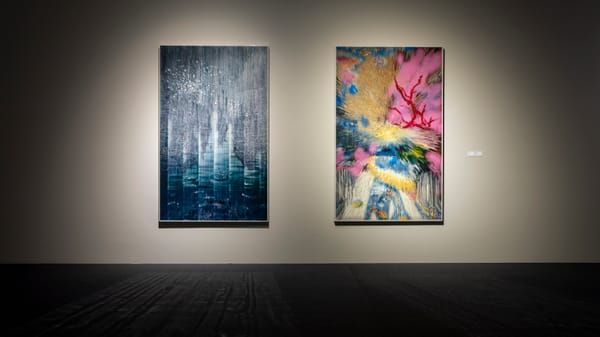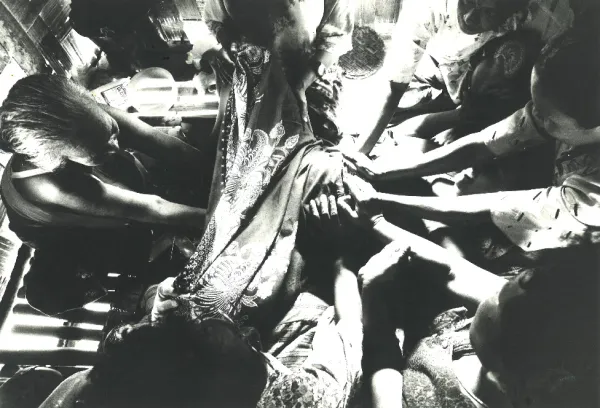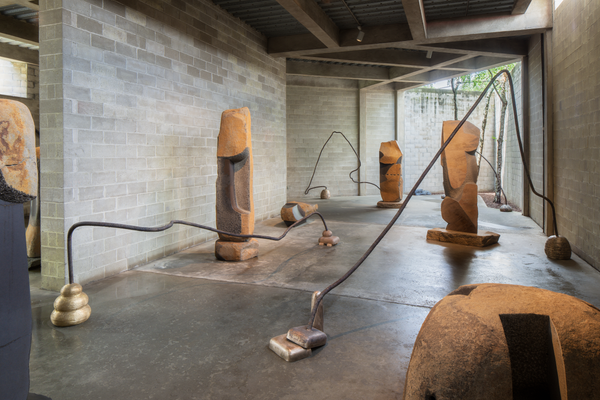Shows
Patty Chang’s “The Wandering Lake”


The title of Patty Chang’s solo exhibition, “The Wandering Lake,” is a reference to Swedish explorer Sven Hedin’s eponymous book published in 1938, in which Hedin documents his search for a mysteriously transient body of water. In 2009, Chang traveled to the northwest province of Xinjiang, China, to find the lake known as Lop Nur for herself. Fraught with logistical challenges as well as political tension, her trip to this remote setting and the footage she filmed became the source material for the work Minor (2010). For eight subsequent years, Chang continued to chase water as both a physical force and metaphorical inspiration. The video and photographic installations, performances, sculptures, writings and collected ephemera that emerged were brought together at the Queens Museum exhibition.
Invocation for a Wandering Lake, Part II (2016) opens the show with the roar of desert winds and noticeable absence of water. Projected onto cardboard panels standing in an irregular zigzag formation, like a map being unfolded, the video then cuts to Chang scrubbing the rusted hull of an abandoned boat resting on the dried floor of Uzbekistan’s shrinking Aral Sea—a result of the Soviet Union’s irrigation projects in the 1960s. Directly contrasting this arid landscape, a second video installation Invocation for a Wandering Lake, Part I (2015) transports us to the coastline of Newfoundland, Canada, where we hear the tide lapping gently against a rocky shore. The carcass of a dead sperm whale floats on the screen. Chang performs a ritualistic washing of the whale’s body, which she describes as being prompted by emotion: “My sense of mortality was overwhelming. It was a sense of sorrow, an indescribable emptiness.” Part I explores an intimately personal connection to the natural world just as Part II investigates the greater human impact on the environment.
Months after her first sojourn, Chang returned to the Aral Sea, hoping to film the infrastructure surrounding the body of water—an act prohibited by the Uzbek government. In her artist book, Chang recalls that she was weaning her son at the time, and so decided to continue pumping her breast milk, which she disposed of in whatever receptacle was available. Mounted on a mazelike arrangement of plywood that echoes the Invocation for a Wandering Lake configurations, Letdown (Milk) (2017) features photographs of opaque, white liquid sitting in teacups, a glass in a hotel bathroom and even a discarded paint tray. Interspersed among the shots of discarded breast milk are photos of fields, irrigation canals and pipes. Paths in the maze dead-end at unexpected images of either, thus underlining Chang’s substitution of a mother’s milk, which provides nourishment, for the water needed for farming.

In the next gallery, Chang further examined the relationship between people and water on an even grander scale by returning to China, where she followed the South-to-North Water Diversion Project: the longest aqueduct in the world. Configurations (2017) merges documentary and travelogue with performance, supplemented by the artist’s first-person narration, which is subtitled in Chinese in a second video channel. Animated maps chart the grid-like plan; graphical text outlines the environmental risks; and both video and still photography capture the immensity of the infrastructure carving through the land, its manufactured, static stance juxtaposed with the historically unbridled nature of China’s four major rivers. In another scene, Chang urinates into a potted plant against a reproduction of the painting The Yellow River Breaches Its Course (circa 1160–1225 CE) by Song Dynasty artist Ma Yuan. The performance was repeated throughout her expedition with the aid of a feminine urinary device that funneled the waste. A multitude of glass sculptures, modeled off of such devices, was displayed alongside the videos. A third channel on the opposite wall of the gallery showed Chang carrying the potted plant, which she had fertilized with her urine. The artist’s endeavors to exert control over her biological urges serve as an analogy for the Chinese government’s massive undertaking to re-direct the flow of water, while the depictions of bodily fluids remind us that water is a life force.
The disappearing lakes, the draining of rivers and the extinguishing of a life-giving resource evoke a contemplation of our ravaged Earth, and the knowledge that we’re experiencing a sixth mass extinction. Paralleling these reflections are moments of personal grieving, such as when the artist confronts the passing of her father in the video Que Sera, Sera (2013). The narratives that emerge out of her meditative wanderings around life and death mirror a sobering reality—our new normal, which Chang describes as “living while mourning.”
Patty Chang’s “The Wandering Lake, 2009–2017” is on view at Queens Museum, New York, until March 4, 2018.







